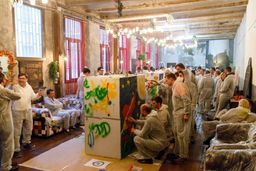Blog

Ideas for Incorporating interactive technologies into your event
It seems that all modern events strive to use modern technology and be more interactive. In reality, however, many events are producing the same old ideas instead of offering something innovative.
Technology is available, but budget can often be a limiting factor for trying something new. We have put together a selection of event-appropriate technology and share the truth about how to use it, important considerations, and how much you can expect to pay to rent it for your event. We also detail the pros and cons of standard and custom content, and provide some tips to make the most of interactive technology.
Interesting Technologies to Enhance Your Event:
**Mirrors **
Mirror is a hybrid display of mirror and signage combined. It can give a reflection of the user and also share additional digital information or advertising.
Mirror can be used to share scheduled information or marketing messages for your event or sponsors in an unusual way and make the most of every square inch of real estate. It can be programmed to display advertising that then stops when the proximity sensor determines someone is close and needs to use the mirror, before automatically starting again after a period of inactivity. Alternatively, advertising can be displayed on a part of the screen even when the mirror is in use.
A custom-programmed "magic mirror" can be particularly effective for fashion exhibitors looking to impress and transform the "try-on" experience. It allows for reflection and image transmission. This can show how the item would look on the person without them actually having to undress. The touchscreen allows the user to change clothing combinations, get stylist recommendations, request staff assistance, or make a purchase. It's an opportunity for exhibitors to increase the likelihood of more sales without increasing the number of staff and the footprint required for additional exhibition floor space.
Virtual Reality (VR) Headsets
Virtual reality is a computer-generated simulation of a 3D environment that an individual can interact with, through a headset, in an apparently real or physical way.
Virtual reality headsets can transport attendees to another world and are guaranteed to intrigue and excite attendees. It offers an immersive and credible experience. Commercial content is available, such as walking with dinosaurs, flying, or a car racing track. Custom-made VR content tailored to a company can also be developed.
VR headsets can be used in a conference plenary session, allowing delegates to experience another virtual world, all at the same time, in an individual but shared experience. It's a big draw for sponsors and exhibitors who want to attract attention and get people talking. It could bring to life a product or scenario that can't be transported to the event, for example, a large product like an airplane. Users could rotate, move, explore, and walk around the product from a bird's-eye view or, indeed, walk through the space as if they were in it.

Videogames
Video game consoles are computers or devices that can be used for interactive games between one or more players.
Game consoles can be used for competitions and team-building activities as a fun engagement element for a larger event. They can be a great bonding activity and generate a lot of adrenaline. A leaderboard can be set up and managed throughout the event, and a crowd will often gather to cheer on the competitors.

Video Projections
A series of screens that come together and integrate seamlessly to create a larger viewing area.
Large video projections on walls can create a wow factor in a variety of ways. They can create an immersive presentation experience in the main conference room, add a wow factor to a venue or exhibition stand, be used in a meeting room to connect participants in different locations for a virtual meeting, or be used to broadcast live content.
There are many creative ways to display content. Live camera footage can be shown, or scheduled content can be displayed to communicate brand messages. When placed in high-traffic areas, it can ensure that it captures attention and communicates important information to guests.

*Touchscreen
Touchscreens use a touch-sensitive surface to display images, and the user can interact with and control them.
They are a great way to share event information or collect visitor data. They are popular among exhibitors for displaying product information, answering questions, showcasing offers, or placing orders through a secure checkout point. They can even be used to play one or multiple games at the same time. Using a table format, as opposed to a wall screen, means that attendees must come closer to see it, which is the ideal opportunity for sponsors to be available if they need more advice.
It's an easy way to make the guest a participant in your event.

3 Essential Tips for Creating Interactive Event Content
Consult with your hardware provider about the exact specifications of the technology, especially the aspect ratio and resolution.
Ask the hardware provider to test your content live before the event and send you a video to confirm.
Check the readability of the font in all content, as it can often be the biggest issue encountered with interactive event content.
**In Conclusion ** Interactive technology can be a great addition to your event in terms of engagement, sponsor/exhibitor interactions, and the wow factor. They can also offer efficiencies and savings in terms of staffing and space requirements. These technologies provide ample scope to incorporate innovative technology into your event and demonstrate that there are options available for all event budgets.
Go ahead and apply innovative technologies to your event.






